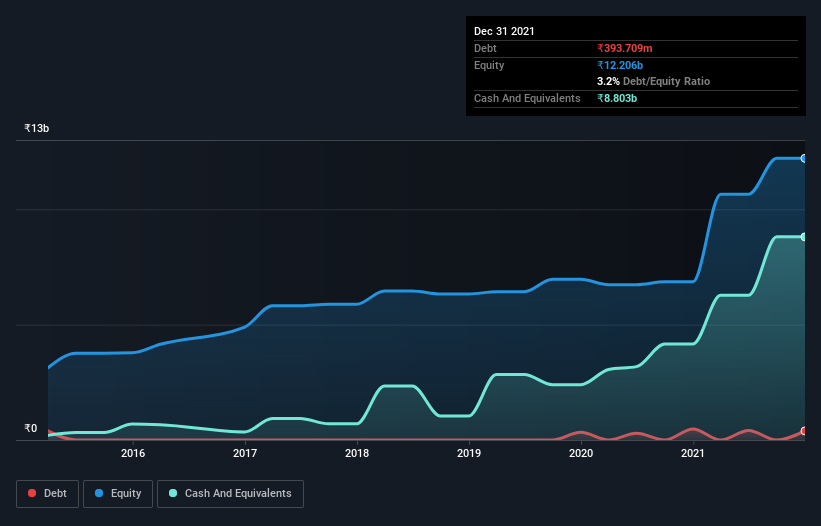These 4 Measures Indicate That Supreme Petrochem (NSE:SUPPETRO) Is Using Debt Safely

Legendary fund manager Li Lu (who Charlie Munger backed) once said, 'The biggest investment risk is not the volatility of prices, but whether you will suffer a permanent loss of capital.' So it seems the smart money knows that debt - which is usually involved in bankruptcies - is a very important factor, when you assess how risky a company is. Importantly, Supreme Petrochem Limited (NSE:SUPPETRO) does carry debt. But is this debt a concern to shareholders?
When Is Debt Dangerous?
Debt is a tool to help businesses grow, but if a business is incapable of paying off its lenders, then it exists at their mercy. In the worst case scenario, a company can go bankrupt if it cannot pay its creditors. However, a more frequent (but still costly) occurrence is where a company must issue shares at bargain-basement prices, permanently diluting shareholders, just to shore up its balance sheet. Of course, plenty of companies use debt to fund growth, without any negative consequences. The first step when considering a company's debt levels is to consider its cash and debt together.
See our latest analysis for Supreme Petrochem
How Much Debt Does Supreme Petrochem Carry?
As you can see below, Supreme Petrochem had ₹393.7m of debt at September 2021, down from ₹481.6m a year prior. However, it does have ₹8.80b in cash offsetting this, leading to net cash of ₹8.41b.

How Strong Is Supreme Petrochem's Balance Sheet?
According to the last reported balance sheet, Supreme Petrochem had liabilities of ₹6.90b due within 12 months, and liabilities of ₹642.1m due beyond 12 months. Offsetting this, it had ₹8.80b in cash and ₹3.06b in receivables that were due within 12 months. So it can boast ₹4.32b more liquid assets than total liabilities.
This surplus suggests that Supreme Petrochem has a conservative balance sheet, and could probably eliminate its debt without much difficulty. Simply put, the fact that Supreme Petrochem has more cash than debt is arguably a good indication that it can manage its debt safely.
Better yet, Supreme Petrochem grew its EBIT by 139% last year, which is an impressive improvement. That boost will make it even easier to pay down debt going forward. The balance sheet is clearly the area to focus on when you are analysing debt. But you can't view debt in total isolation; since Supreme Petrochem will need earnings to service that debt. So when considering debt, it's definitely worth looking at the earnings trend. Click here for an interactive snapshot.
But our final consideration is also important, because a company cannot pay debt with paper profits; it needs cold hard cash. Supreme Petrochem may have net cash on the balance sheet, but it is still interesting to look at how well the business converts its earnings before interest and tax (EBIT) to free cash flow, because that will influence both its need for, and its capacity to manage debt. Over the most recent three years, Supreme Petrochem recorded free cash flow worth 78% of its EBIT, which is around normal, given free cash flow excludes interest and tax. This cold hard cash means it can reduce its debt when it wants to.
Summing up
While we empathize with investors who find debt concerning, you should keep in mind that Supreme Petrochem has net cash of ₹8.41b, as well as more liquid assets than liabilities. And it impressed us with its EBIT growth of 139% over the last year. So we don't think Supreme Petrochem's use of debt is risky. There's no doubt that we learn most about debt from the balance sheet. But ultimately, every company can contain risks that exist outside of the balance sheet. Be aware that Supreme Petrochem is showing 1 warning sign in our investment analysis , you should know about...
At the end of the day, it's often better to focus on companies that are free from net debt. You can access our special list of such companies (all with a track record of profit growth). It's free.
New: Manage All Your Stock Portfolios in One Place
We've created the ultimate portfolio companion for stock investors, and it's free.
• Connect an unlimited number of Portfolios and see your total in one currency
• Be alerted to new Warning Signs or Risks via email or mobile
• Track the Fair Value of your stocks
Have feedback on this article? Concerned about the content? Get in touch with us directly. Alternatively, email editorial-team (at) simplywallst.com.
This article by Simply Wall St is general in nature. We provide commentary based on historical data and analyst forecasts only using an unbiased methodology and our articles are not intended to be financial advice. It does not constitute a recommendation to buy or sell any stock, and does not take account of your objectives, or your financial situation. We aim to bring you long-term focused analysis driven by fundamental data. Note that our analysis may not factor in the latest price-sensitive company announcements or qualitative material. Simply Wall St has no position in any stocks mentioned.
About NSEI:SPLPETRO
Supreme Petrochem
Manufactures and sells polystyrene, expandable polystyrene, masterbatches and compounds of styrenics, other polymers, and extruded polystyrene insulation board in India and internationally.
Flawless balance sheet with high growth potential and pays a dividend.
Market Insights
Community Narratives




